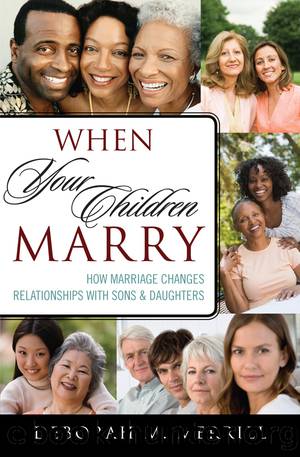When Your Children Marry by Merrill Deborah M.;

Author:Merrill, Deborah M.;
Language: eng
Format: epub
Publisher: Rowman & Littlefield Publishers
Published: 2011-01-01T00:00:00+00:00
The Mother, Son, and Daughter-In-Law Triad
What is it about the triad between mother, son, and daughter-in-law that poses such a challenge? Traditionalists would argue that the new wife is taking the place of the mother, but such an argument infantilizes adult men in our society. Nor would I argue that mothers-in-law and daughters-in-law are so dependent on men that they are actually competing for them or battling to control them. However, there are a number of structural factors that challenge the triad of mother, son, and daughter-in-law.
Earlier researchers have examined the factors that lead to difficult relationships between mothers-in-law and daughters-in-law.14 In-laws lack a shared history that otherwise binds family members. Likewise, in-laws are neither totally in nor out of the family but are thrust into situations where they are expected to treat one another like family and meet all of the obligations of family. Daughters-in-law feel particularly alienated when the boundaries around her husbandâs family are impermeable and the family does not incorporate her. Likewise, mothers-in-law become resentful if they feel that their daughters-in-law have not bridged the gap between them or included them in their sonsâ lives. Thus, much of the tension revolves around the creation of a new and separate family. Hostilities tend to remain in situations where the initial separation of families goes poorly. Problems also arise in situations where the families disagree about the acceptable degree of separation from one another.15
What about the relationship between the mother and son, though? Results of this research suggest that additional structural factors account for the unique changes in relationships between mothers and their sons following the sonsâ marriage. In particular, mothers become dissatisfied with the relationship in situations where the couple spends more time with the wifeâs family than the husbandâs family following marriage. According to the adult children in this study, couples are only slightly more likely to spend more time with the wifeâs family than the husbandâs family.16 Yet mothers suggest that it happens more frequently than this. According to the mothers, couples tend to spend more time with the wifeâs family than with the husbandâs family. This confirms earlier suggestions that men get pulled in to their wifeâs family more frequently than women get pulled in to their husbandâs family.17 In fact, any decrease in time that men spent with their family was experienced negatively by many of the mothers. While mothers did not see this as âlosingâ their sons, they did believe that it was a lessening of ties, which some mothers resented.
Sons expressed frustration at the conflict between their mothers and wives. One of the sons said, âWhen my back is to the wall like that . . . caught between them . . . I go red and I just have to leave for a couple of hours.â When asked what he meant by his back being to the wall, he said, âIt is usually a situation where my mother wants to do one thing and [my wife] wants us to do something else.
Download
This site does not store any files on its server. We only index and link to content provided by other sites. Please contact the content providers to delete copyright contents if any and email us, we'll remove relevant links or contents immediately.
| Early Childhood | Parenting Boys |
| Parenting Girls | School-Age Children |
| Single Parents | Teenagers |
The Lost Art of Listening by Michael P. Nichols(7158)
Rich Dad Poor Dad by Robert T. Kiyosaki(6174)
We Need to Talk by Celeste Headlee(5412)
I Love You But I Don't Trust You by Mira Kirshenbaum(3705)
The Complete Idiot's Guide to Coping With Difficult People by Arlene Uhl(3066)
Rich Dad Poor Dad: What The Rich Teach Their Kids About Money - That The Poor And Middle Class Do Not! by Robert T. Kiyosaki(2833)
Life Hacks by Dan Marshall(2374)
The Book You Wish Your Parents Had Read (and Your Children Will Be Glad That You Did) by Philippa Perry(2349)
A Burst of Light by Audre Lorde(2347)
Dealing with People You Can't Stand by Dr. Rick Brinkman(2283)
An Odyssey by Daniel Mendelsohn(2204)
The Expectant Father by Armin A. Brott & Jennifer Ash(2167)
Teach Your Child How to Think by Edward De Bono(2087)
No Time to Say Goodbye(1996)
The Out-of-Sync Child by Carol Stock Kranowitz(1984)
What I Need by J. Daniels(1965)
The 7 Habits Of Highly Effective Teens by Covey Sean(1937)
I Don't Belong to You by Keke Palmer(1915)
The Self-Driven Child by William Stixrud PhD & Ned Johnson(1883)
